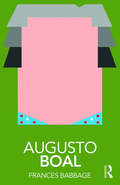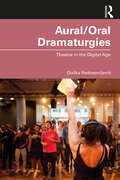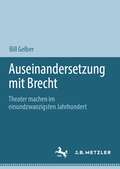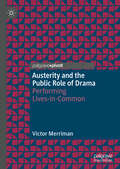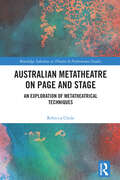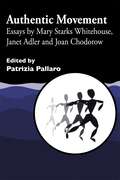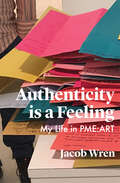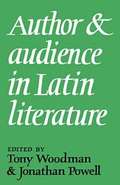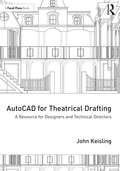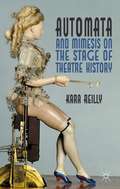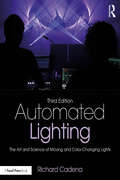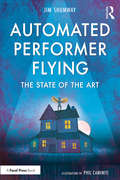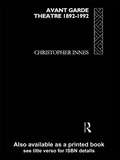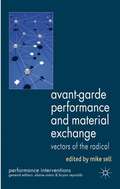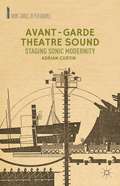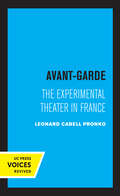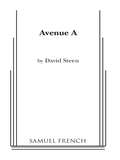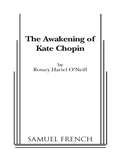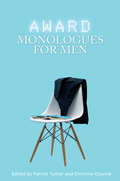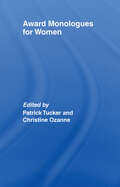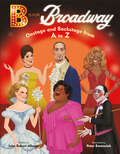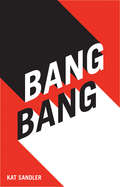- Table View
- List View
Augustine's Inner Dialogue: The Philosophical Soliloquy in Late Antiquity
by Brian StockAugustine's philosophy of life involves mediation, reviewing one's past and exercises for self-improvement. Centuries after Plato and before Freud he invented a 'spiritual exercise' in which every man and woman is able, through memory, to reconstruct and reinterpret life's aims. Brian Stock examines Augustine's unique way of blending literary and philosophical themes. He proposes a new interpretation of Augustine's early writings, establishing how the philosophical soliloquy (soliloquium) has emerged as a mode of inquiry and how it relates to problems of self-existence and self-history. The book also provides clear analysis of inner dialogue and discourse and how, as inner dialogue complements and finally replaces outer dialogue, a style of thinking emerges, arising from ancient sources and a religious attitude indebted to Judeo-Christian tradition.
Augusto Boal (Routledge Performance Practitioners)
by Frances BabbageThis newly-updated volume looks at the scope of Augusto Boal's career from his early work as a playwright and director in Sao Paulo in the 1950s, to the development of his ground-breaking manifesto in the 1970s for a 'Theatre of the Oppressed'. Offering fascinating reading for anyone interested in the role that theatre can play in stimulating social and personal change, this useful study includes: a biographical and historical overview of Boal's career as theatre practitioner and director an in-depth analysis of Boal's classic text on radical theatre an exploration of training and production techniques practical guidance to Boal's workshop methods This is an essential introduction to the work of a practitioner who has had a tremendous impact on contemporary theatre. As a first step towards critical understanding, and as an initial exploration before going on to further, primary research, Routledge Performance Practitioners are unbeatable value for today’s student.
Aural/Oral Dramaturgies: Theatre in the Digital Age
by Duška RadosavljevićAural/Oral Dramaturgies: Theatre in the Digital Age focuses on the ‘aural turn’ in contemporary theatre-making, examining a number of seemingly disparate trends that foreground speech and sound -- ‘post-verbatim’ theatre, 'amplified storytelling' (works using microphones and headphones), and ‘gig theatre’ that incorporates live music performance. Its main argument is that the dramaturgical underpinnings of these works contribute to an understanding of theatre as an extra-literary activity, greater than the centrality of the script that traditionally dominated many historical discussions. This quality is usually expressed in terms of the corporeality in dance and physical theatre, but the aural/oral turn gives an alternative viewpoint on the interplay between text and performance. The book's case studies draw on the ways in which a range of theatre companies engage with the dramaturgy of speech and sound in their work. It is further accompanied by a specially curated collection of digital resources, including interviews, conversations, and presentations from artists and academics. This is a key text for scholars, students, and practitioners of contemporary performance, and anyone working with dramaturgies of orality and aurality in today’s performance environment.
Auseinandersetzung mit Brecht: Theater machen im einundzwanzigsten Jahrhundert
by Bill GelberDieses Buch ist ein Plädoyer für Bertolt Brechts anhaltende Bedeutung in einer Zeit, in der die Ereignisse des 21. Jahrhunderts nach einer studierten Art und Weise schreien, Theater für den sozialen Wandel zu produzieren. Hier wird ein einzigartiger Schritt-für-Schritt-Prozess für die Umsetzung von Brechts Arbeitsweisen auf der Bühne vorgestellt, wobei die 2015 an der Texas Tech University entstandene Produktion von Brechts "Mutter Courage und ihre Kinder" als Modell für die Erkundung dient. Besondere Brecht-Konzepte - das Epos, die Verfremdung, die Fabel, der Gestus, die Historisierung, die Literarisierung, das "Nicht...aber", das Arrangement und die Trennung der Elemente - werden erläutert und auf Szenen und Stücke angewendet. Brechts komplizierte Beziehung zu Konstantin Stanislawski wird auch in Bezug auf ihre unterschiedlichen Ansichten über das Schauspiel erforscht. Für Theaterpraktiker und -pädagogen ist dieser Band eine Aufzeichnung des pädagogischen Engagements, eine empirische Studie von Brechts Werk in der Aufführung an einer höheren Bildungseinrichtung mit Studenten und Absolventen.
Austerity and the Public Role of Drama: Performing Lives-in-Common
by Victor MerrimanThis book asks what, if any, public role drama might play under Project Austerity – an intensification phase of contemporary liberal political economy. It investigates the erosion of public life in liberal democracies, and critiques the attention economy of deficit culture, by which austerity erodes life-in-common in favour of narcissistic performances of life-in-public. It argues for a social order committed to human flourishing and deliberative democracy, as a counterweight to the political economy of austerity. It demonstrates, using examples from England, Ireland, Italy, and the USA, that drama and the academy pursue shared humane concerns; the one, a critical art form, the other, a social enabler of critical thought and progressive ideas. A need for dialogue with emergent forms of collective consciousness, new democratic practices and institutions, shapes a manifesto for critical performance, which invites universities and cultural workers to join other social actors in imagining and enabling ethical lives-in-common.
Australian Metatheatre on Page and Stage: An Exploration of Metatheatrical Techniques (Routledge Advances in Theatre & Performance Studies)
by Rebecca ClodeThis book offers the first major discussion of metatheatre in Australian drama of the late twentieth and early twenty-first centuries. It highlights metatheatre’s capacity to illuminate the wider social, cultural, and artistic contexts in which plays have been produced. Drawing from existing scholarly arguments about the value of considering metatheatre holistically, this book deploys a range of critical approaches, combining textual and production analysis, archival research, interviews, and reflections gained from observing rehearsals. Focusing on four plays and their Australian productions, the book uses these examples to showcase how metatheatre has been utilised to generate powerful elements of critique, particularly of Indigenous/non-Indigenous relations. It highlights metatheatre’s vital place in Australian dramatic and theatrical history and connects this Australian tradition to wider concepts in the development of contemporary theatre. This illuminating text will be of interest to students and scholars of Australian theatre (historic and contemporary) as well as those researching and studying drama and theatre studies more broadly.
Authentic Movement: Essays by Mary Starks Whitehouse, Janet Adler and Joan Chodorow
by Joan Chodorow Zoe Arlene Avstreih Suzanne Lovell Patrizia Pallaro Lisa Tsetse Bill Mccully Andrea J. Olsen Heidi J. Ehrenreich Margareta Neuberger Daphne A. Lowell Barbara Holifield Cassielle Alaya Bull Antonella Adorisio Sox Sperry Tina Stromsted Neala Haze Wendy Goulston Shira Musicant Janet Adler Judith Koltai Jan Sandman Wendy Mcginty-Wyman Julie Joslyn Brown Ariane Goodwin Soraia Jorge Marcia Plevin Alton Wasson David Mars Sandy Dibbell-Hope Lynn Garland Susan Frieder Anne Hebert Smith Carol Fields Susan Bauer`Patrizia Pallaro's second volume of essays on Authentic Movement, eight years after her first, is a tour de force. It is indeed "an extraordinary array of papers", as Pallaro puts it, and an immensely rich, moving and highly readable sweep through the landscapes of Authentic Movement, "this form of creative expression, meditative discipline and/or psychotherapeutic endeavour...You don't need to practise Authentic Movement to get a lot out of this book, but it certainly helps! I defy anyone to read the first two sections and not be curious to have their own experience.' - Sesame Institute `Authentic Movement can be seen as a means by which analysts can become more sensitive to unconscious, especially pre-verbal aspects of themselves and their patients.' -Body Psychotherapy Journal Newsletter, No. 30 `This book is a collection of articles, some of which are interviews, brought together for the first time. It is very valuable to have them all together in one place...It is a wonderful collection of articles on topics you have always wanted to read, such as the role of transference in dance therapy or Jung and dance therapy. The book also includes scripts for exercises.' - Somatics Authentic Movement, an exploration of the unconscious through movement, was largely defined by the work of Mary Starks Whitehouse, Janet Adler and Joan Chodorow. The basic concepts of Authentic Movement are expressed for the first time in one volume through interviews and conversations with these important figures, and their key papers. They emphasize the importance of movement as a means of communication, particularly unconscious or `authentic' movement, emerging when the individual has a deep, self-sensing awareness - an attitude of `inner listening'. Such movement can trigger powerful images, feelings and kinesthetic sensations arising from the depths of our stored childhood memories or connecting our inner selves to the transcendent. In exploring Authentic Movement these questions are asked: - How does authentic movement differ from other forms of dance and movement therapy? - How may `authentic' movement be experienced?
Authenticity is a Feeling: My Life in PMR-ART
by Jacob WrenAuthenticity is a Feeling: My Life in PME-ART is a compelling hybrid of history, memoir, and performance theory. It tells the story of the interdisciplinary performance group PME-ART and their ongoing endeavour to make a new kind of highly collaborative theatre dedicated to the fragile but essential act of "being yourself in a performance situation."Written, among other things, to celebrate PME-ART's twentieth anniversary, the book begins when Jacob Wren meets Sylvie Lachance and Richard Ducharme, moves from Toronto to Montreal to make just one project, but instead ends up spending the next twenty years creating an eccentric, often bilingual, art. It is a book about being unable to learn French yet nonetheless remaining Co-Artistic Director of a French-speaking performance group, about the Spinal Tap-like adventures of being continuously on tour, about the rewards and difficulties of intensive collaborations, about making performances that break the mold and confronting the repercussions of doing so. A book that aims to change the rules for how interdisciplinary performance can be written about today.When Jacob finished a first draft of the book he sent it to many of those who had co-created or worked on PME-ART projects asking for their comments. Therefore, the book also features contributions from: Caroline Dubois, Richard Ducharme, Claudia Fancello, Marie Claire Forté, Adam Kinner, Sylvie Lachance, Nadia Ross, Yves Sheriff, Kathrin Tiedemann and Ashlea Watkin.
Author and Audience in Latin Literature
by Tony Woodman Jonathan PowellThe relationship between the author and his audience has received much critical attention from scholars in non-classical disciplines yet the nature of much ancient literature and of its 'publication' meant that audiences in ancient times were more immediate to their authors than in the modern world. This book contains essays by distinguished scholars on the various means by which Latin authors communicated effectively with their audiences. The authors and works covered are Cicero, Catullus, Lucretius, Propertius, Horace's Odes, Virgil's Aeneid, Ovid's Metamorphoses, Senecan tragedy, Persius, Pliny's letters, Tacitus' Annals and medieval love lyric. Contributors have provided detailed analyses of particular passages in order to throw light on the many different ways in which authors catered for their audiences by fulfilling, manipulating and thwarting their expectations; and in an epilogue the editors have drawn together the issues raised by these contributions and have attempted to place them in an appropriate critical context.
Authoring Performance
by Avra SidiropoulouA historical, theoretical, and comparative study of the emergence of the director-as-author phenomenon, posing questions of authorship and redefining the relationship between 'playwright' and the director-playwright.
AutoCAD for Theatrical Drafting: A Resource for Designers and Technical Directors
by John KeislingAutoCAD for Theatrical Drafting provides an introduction to the software AutoCAD, specifically focusing on how to navigate the commands most commonly used when creating design, construction and installation drafting plates for theatrical use. Beginning with a step-by-step tutorial of how to download the program and a review of theatrical drafting standards, the text details commands used in 2D drafting and 3D modeling and how to create theatrical drafting plates using AutoCAD that meet those drafting standards. It also provides guidance on how to transition from 2D drafting to 3D modeling, how to use 3D models to create camera views and animations and how to use 3D models for production and engineering purposes. Intended as a resource for the beginning and intermediate AutoCAD user, AutoCAD for Theatrical Drafting provides easy-to-follow instructions that readers can refer to while using the AutoCAD software.
Automata and Mimesis on the Stage of Theatre History
by Kara ReillyThe automaton, known today as the robot, can be seen as a metaphor for the historical period in which it is explored. Chapters include examinations of Iconoclasm's fear that art might surpass nature, the Cartesian mind/body divide, automata as objects of courtly desire, the uncanny Olympia, and the revolutionary Robots in post-WWI drama.
Automated Lighting: The Art and Science of Moving and Color-Changing Lights
by Richard CadenaAutomated Lighting: The Art and Science of Moving and Color-Changing Lights, Third Edition (formerly Automated Lighting: The Art and Science of Moving Light) continues to be the most trusted text for working and aspiring lighting professionals. Now in its third edition, it has been fully updated to reflect the vast changes in stage and studio luminairies—including LEDs, switch-mode power supplies, optics, networking, Ethernet-based protocols like Art-Net and sACN, wireless DMX, and much more. Its written in clear, easy-to-understand language and includes enough detailed information to benefit for the most experienced technicians, programmers, and designers. Additional content and resources are provided at the author's website www.automatedlighting.pro.
Automated Performer Flying: The State of the Art
by Jim ShumwayAutomated Performer Flying: The State of the Art shares the secrets of performer flying in entertainment history and provides step-by-step instructions on how to create a performer flying effect from scratch. This book sheds light on all aspects of performer flying, covering its history, explaining concepts like mechanical compensation versus electrical compensation, providing guidance on how to calculate stopping distances and forces, and sharing tips on how to build successful relationships with performers. Case studies of prominent productions featuring performer flying, including Cirque du Soleil and Beyoncé, are included throughout. Written for technical directors, theatrical riggers, and students of rigging, technical direction, and stagecraft courses, Automated Performer Flying takes readers through the process of creating a performer flying effect from the first spark of the idea to opening night.
Avant Garde Theatre: 1892–1992
by Christopher InnesExamining the development of avant garde theatre from its inception in the 1890s right up to the present day, Christopher Innes exposes a central paradox of modern theatre; that the motivating force of theatrical experimentation is primitivism. What links the work of Strindberg, Artaud, Brook and Mnouchkine is an idealisation of the elemental and a desire to find ritual in archaic traditions. This widespread primitivism is the key to understanding both the political and aesthetic aspects of modern theatre and provides fresh insights into contemporary social trends. The original text, first published in 1981 as Holy Theatre, has been fully revised and up-dated to take account of the most recent theoretical developments in anthropology, critical theory and psychotherapy. New sections on Heiner Muller, Robert Wilson, Eugenio Barba, Ariane Mnouchkine and Sam Shepard have been added. As a result, the book now deals with all the major avant garde theatre practitioners, in Europe and North America. Avant Garde Theatre will be essential reading for anyone attempting to understand contemporary drama.
Avant-Garde Performance and Material Exchange
by Mike SellAssembling a remarkable group of scholars, these essays explore how the circulation and exchange of 'vectors of the radical' shape the avant-garde. Mapping the movement of scripts, theatre activists, performances, and other material entities, they provide unprecedented perspectives on the transnational performance culture of the avant-garde.
Avant-Garde Theatre Sound
by Adrian CurtinSound experimentation by avant-garde theatre artists of the late-nineteenth and early-twentieth centuries is an important but ignored aspect of theatre history. Curtin explores how artists engaged with the sonic conditions of modernity through dramatic form, characterization, staging, technology, performance style, and other forms of interaction.
Avant-Garde: The Experimental Theater in France
by Leonard C. PronkoThis title is part of UC Press's Voices Revived program, which commemorates University of California Press’s mission to seek out and cultivate the brightest minds and give them voice, reach, and impact. Drawing on a backlist dating to 1893, Voices Revived makes high-quality, peer-reviewed scholarship accessible once again using print-on-demand technology. This title was originally published in 1962.
Avenue A
by David SteenFull Length \ Dark Dramatic Comedy \ 3m, 1f \ Various Settings/Unit Set \ Described as "a sideways look at the American dream," Avenue A is the gripping tale of an ex-con struggling to create his own family of misfits as an old prison buddy mysteriously returns for one final visit. It is a carefully crafted and mordantly funny look at rebirth amidst urban decay. Avenue A has been greeted with tremendous praise from audiences and critics alike. \ "A frayed nerve of a drama...poke your head in and take a long sickening look at the freaks." The New York Times
Awakening of Kate Chopin
by Rosary Hartel O'NeillKate Chopin, author of The Awakening, struggles to hold onto her marriage and her six small children as she launches her career as a novelist in 1884. Frustrating her attempts are: her wealthy next door neighbor, wanting to prove his masculinity; her jealous husband, stricken with malaria; the little sex-pot seamstress next door, the town gossip; and the bankrupt cotton business, which consumes all of her time. This crazy cacophony of personalities ends up compelling Kate toward her goal of becoming a famous author.
Award Monologues for Men
by Patrick Tucker Christine OzanneAward Monologues for Men is a collection of fifty monologues taken from plays written since 1980 that have been nominated for the Pullitzer Prize, the Tony and the Drama Desk Awards in New York, and The Evening Standard and Laurence Olivier Awards in London. The book provides an excellent range of up-to-date audition pieces, usefully arranged in age groups, and is supplemented with audition tips to improve your acting, and to ensure you give your best possible performance.
Award Monologues for Women
by Patrick Tucker Christine OzanneAward Monologues for Women is a collection of fifty-four monologues taken from plays written since 1980 that have been nominated for the Pullitzer Prize, the Tony and the Drama Desk Awards in New York, and The Evening Standard and Laurence Olivier Awards in London. The book provides an excellent range of up-to-date audition pieces, usefully arranged in age groups, and is supplemented with audition tips to improve your acting, and to ensure that the best possible performance.
B Is for Broadway: Onstage and Backstage from A to Z
by John Robert Allman&“A must-have for all Broadway lovers—B Is for Broadway—a book I am actually in!!! I am buying a dozen.&” —ROSIE O&’DONNELL, Isabelle Stevenson Award recipient, three-time Tony Awards host, and Emmy Award winnerNew from the creators of A Is for Audra: Broadway's Leading Ladies from A to Z! From AUDITIONS to ZIEGFELD, grab a ticket to this smash-hit, rhythmic alphabet book featuring your favorite performers, creators, songs, and shows from the Broadway stage!Step into the spotlight and celebrate a cavalcade of Broadway legends! Start with "A" for "audition" with the iconic line-up from A Chorus Line, then peek behind "B" to see the "backstage" buzz, and dance along with "C" for "choreographers".Children and grown-ups alike can spot beloved stars and creators from today and yesterday, such as Lin-Manuel Miranda, Patti LuPone, Michael Bennett, Jennifer Holliday, Ethel Merman, and Billy Porter. Readers will also see famous New York theaters, beloved shows such as Hamilton and Hairspray, and the crew, stylists, and technicians who are vital to each performance. It's a celebration of the American stage that no fan is going to want to miss.A portion of the proceeds from the sale of this book is donated to The Actors Fund.&“We are honored that a portion of the proceeds of author John Robert Allman and illustrator Peter Emmerich&’s B is For Broadway will go to support our programs. The Actors Fund is proud to be at the forefront of helping everyone in the entertainment community with emergency financial assistance and supportive services, and we&’re grateful that this wonderful new work will help those in need in our performing arts community.&” —Joseph P. Benincasa, President & CEO, The Actors FundB Is for Broadway is a hit with the stage's greatest stars!&“B Is for Broadway celebrates the entire Broadway community—backstage, onstage, everyone! who works in our performing arts and entertainment community. I&’m honored to be a part of that beautiful community, and this lovely book.&” —BEBE NEUWIRTH, Tony and Emmy Award–winning dancer, singer, actress (Sweet Charity, Chicago, Cheers), and Vice Chair of The Actors Fund &“E is for excited, which is what I am to be included in this book to benefit the incredible work of The Actors Fund.&” —BRIAN STOKES MITCHELL, Tony Award–winning actor and Board Chair of The Actors Fund &“The illustrations—gorgeous. The rhymes—delicious. This book—a must-have! B is for Broadway and buy-it-now!&” —KRISTIN CHENOWETH, Tony Award–winning actress (You&’re a Good Man, Charlie Brown) &“What a dynamite willkommen to the world of Broadway!&” —JOEL GREY, Tony Award and Oscar–winning actor (Cabaret) &“B Is for Broadway is a gorgeous children&’s book that will introduce a young person to all the magic of theater!&” —ALI STROKER, Tony Award–winning actress (Oklahoma!)
BANG BANG
by Kat SandlerLila, a young Black ex-cop, has been on leave from the police force ever since she shot an unarmed Black youth. She’s moved back in with her mother, Karen, and is drinking beer for breakfast. So when Tim, a white playwright, shows up at her door to casually inform her that his play inspired by her experience is being adapted into a movie, Lila’s trauma is dragged out for speculation once again. The star of the film, their ex-cop bodyguard and Karen are pulled into the fight, leading to an epic metatheatrical standoff in a living room play about a living room play about gun violence, police, art and appropriation. This dark, fast-paced dramedy by the author of Punch Up and Mustard traces the responsibility we have as artists in storytelling and the impact of what it means to be inspired by true events.

